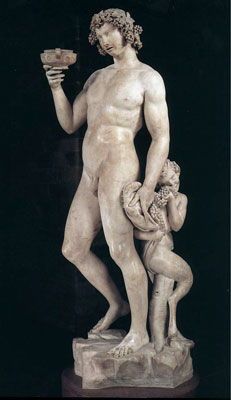The Classical Era
During this period of art there are two very distinct styles that emerge, Rococo and Neoclassical. Rococo is a style that is very light, pastel colors are often used, and very indulgent. While Neoclassical art is often very serious and depict morally good concepts, a very hard shift from Rococo style. This shift in style comes from the evolving public view of the monarchy and public morals.
Rococo
During the first half of the 1700's it is the wealthy and powerful aristocrats who hold the power in society, and the most influence on the art world as they were the majority of the patrons during this time.

Antoine Watteau, Ceres (Summer) (1717/1718), Paris, France. Courtesy of National Gallery of Art
Rococo style reflected the world of the aristocrats, over indulgent and elegant. Ceres by Antoine Watteau shows off this pastel and elegant style and was created towards the beginning of the Rococo period. This piece was a part of series based on the seasons, but the other seasons have been lost over time, and was commissioned by Pierre Crozat for his hotel in Paris.
While not ornate as other pieces from this time, it is still beautiful and soft. I do enjoy this piece, and wish the other seasons had survived. I do think the lion is very interesting, definitely not an accurate lion, the rest of the picture is beautiful.
It was a hotel owner who commissioned it, as at the time it was only the wealthy or aristocratic who patroned the arts, who could afford to do so. They pushed forward these decorative and elegant pieces that are just for show.

François Boucher, Triumph of Venus (1740), Paris, France Courtesy of Artsy
Boucher became someone who helped define the Rococo style as playful, and even erotic. Again this showcases the styles over the top idealization and ornate finesse. The characters within the painting are practically glowing, and cherubs fly through the sky. This piece was commissioned by Count Tessin, and showcases what the middle class were starting to get disgusted with from the artistocrats, over indulgance and loose morals.
It is a detailed piece, and the color palette is soft. I think it is beautiful, not something I would have in my own home, because it is over the top. I find it interesting that the women all have a glow to them, especially Venus, while the males do not. I find that my eye follows the ribbon to Venus, and that despite how much is going on in the painting, she still is the main feature.
Neoclassical
The Neoclassical style is a dramatic shift away from the Rococo style as the public views on morality change. This style is more somber, darker colors, and with the discovery of Pompeii antiquities becomes prevalent again. The biggest change from Rococo is the arts depict morals and stories of heroism, rather than frivioulous scenes.
Jacques Louis David, The Death of Socrates (1787), France Courtesy of The Met
The Death of Socrates displays the somber atmosphere of neoclassical art with muted colors and heavy subject matter and is heavily influenced by antiquities. This was painted by Jacques Louis David following the French Revolution, and depicts Socrates dying for refusing to renounce his beliefs and choosing death willingly for his cause.
Following the public's views on morality and disgust with artistocrats, the arts begin to show stories such as Socrates and other heroes or martyrs.
I like the overall aesthetic of the Rococo period, but appreciate the messages Neoclassical art portays. I like how clean and to the point David's painting is, and how despite that Socrates is about to die he still is still giving one last lesson before his death.
Sources
Baetjer, Katharine. “The Death of Socrates.” Metmuseum.org, 2017, www.metmuseum.org/art/collection/search/436105.
Conisbee, Philip. “Ceres (Summer).” Art Object Page, 1 Jan. 2009, www.nga.gov/collection/art-object-page.46149.html.
“François Boucher Artworks & Famous Paintings.” The Art Story, www.theartstory.org/artist/boucher-francois/artworks/.
Gersh-Nesic, Beth. “Neoclassicism, an Introduction.” Khan Academy, Khan Academy, www.khanacademy.org/humanities/renaissance-reformation/rococo-neoclassicism/neo-classicism/a/neoclassicism-an-introduction.








